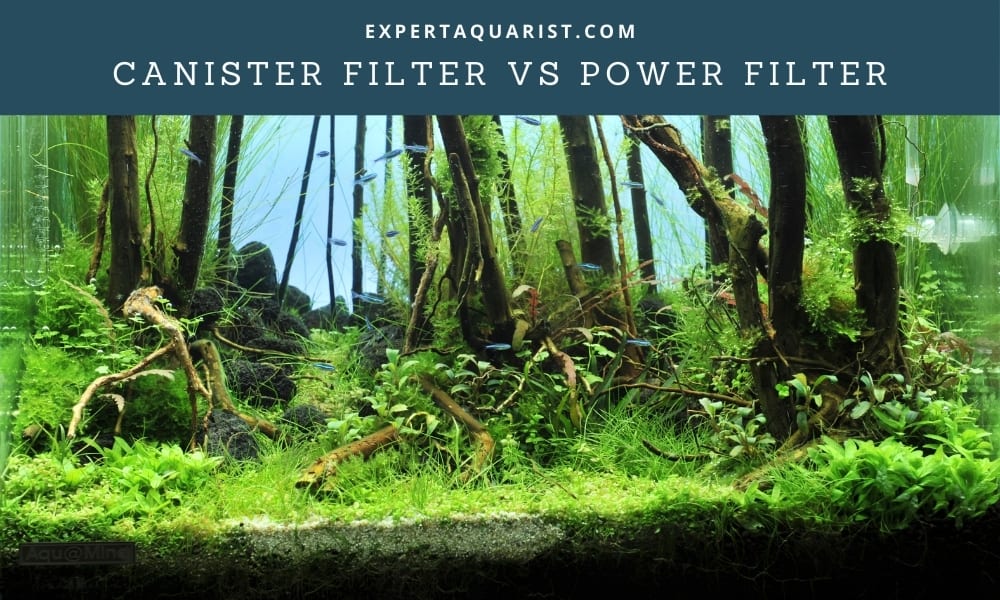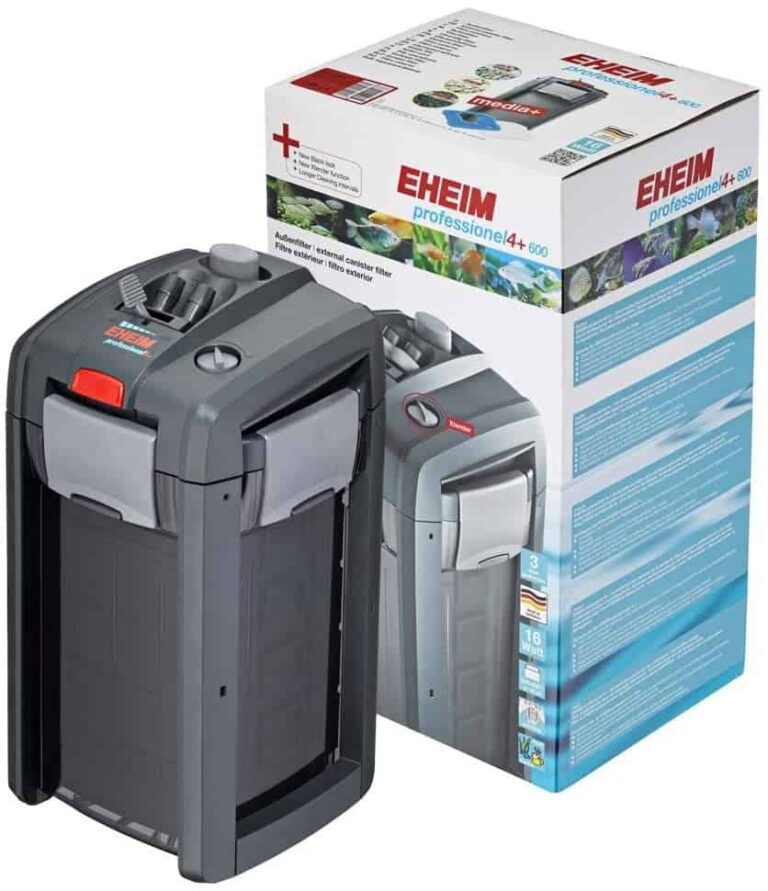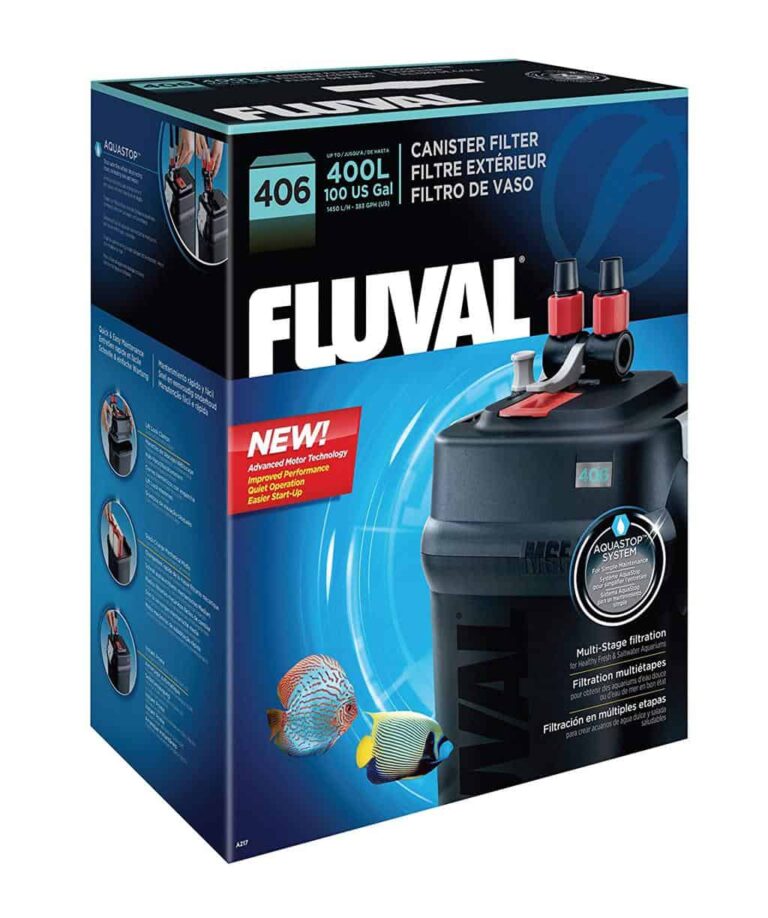I started my aquarium career way back in 2007, and over the years, I gathered knowledge only to understand how dumb I was as a beginner. I kicked off my aquarist life with a medium aquarium, and the filter came by default with the fish tank.
It was a power filter, and I was happy with it. Later, I used a canister filter, sponge filter, and other filtering systems for my different tanks. Honestly speaking, every filter is useful if you truly know how to use it properly.
But confusion rises when it comes to canister filter vs. power filter. Both filters are practically good and have matching features that make it challenging to pick one over another. Hence, I would be putting a comparative discussion between the canister filter and power filter for your convenience.
The discussion will include the working procedure of the two filter types, their maintenance, price, and finally, pros and cons. Thus, you will find it easy to decide which filter is suitable for your aquarium and fishes.

Power Filter Details
Power filters are popularly known as Hang on Back (HoB) filters. They get the name since the filter container is positioned at the back of the aquarium. It is the most widespread filtration available and mostly comes with the aquarium when purchasing a new one.
Hence, most beginners (like me) will start their aquarium fish with power filters. It has a pretty simple working procedure but provides good filtering results.
How power filter works:
Power filters are simple plug an operating device. It has a pump inside the filter and an inlet tube inside the aquarium. When you plug-in the filter with the power outlet and switch it on, water flows through the inlet tube to the inside of the filter.
Inside it, there is a carbon filter pad. As the water passes through the carbon filter pad or cartridge, the actual screening begins to show its magic. The cartridge comes with chemicals that purify the water to keep it hygienic and clean. The working procedure may vary slightly from brands to brands and models to models. But the primary process remains almost identical.
Once the water passes the cartridge and purifies, the tube will release the water into the fish tank. It uses a spillway or overflow technology to give the water to the tank from the filtering container. The drawback of using the power filter is its extreme wastage of the tank water. Since the water comes in the touch of the air, it generates a lot of evaporation.
As a result, you will lose a fair amount of tank water. Thus, you need to refill the fish tank with water more frequently. It can be a hectic procedure for you.
Filtration systems:
A power filter is meant to provide all three types of aquarium filtering, including mechanical, biological, and chemical filtering. Thus, you get the best filtering results with the Hob or power filters. Also, it is useful for all types of fish tanks except the breeding tanks and quarantine tanks.
Maintenance and price:
Power filter is more affordable than one might imagine. In fact, it is one of the most affordable filters for fish tanks in the market. It comes with the new tank set up for free so that beginners will love them.
The filters are available for around $10 t0 $50. The smaller ones are for tanks up to 10 gallons to 15 gallons. The expensive power filters are made for large and community tanks.
The power filters are also easy to operate and maintain. The leading maintenance includes changing the filtering cartridge or carbon pad. Also, if you have other filtering screens, you should change them according to their user manual.
What’s more, you can use the filter without replacing it for an extended period if you regularly return the tank water. In most cases, you can rinse, clean, and put back the carbon filter inside the power filter for your desired results.
What you need to be aware of:
When you install a power filter, you must be aware of two things. These are-
- Water loss
- Fish loss
In the power filter, the water comes in touch with air while going out and in the filter from the tank. So, it evaporates the atmosphere and results in water loss. It means you will have to refill the tank water more frequently than the canister filter.
Furthermore, power filters are powerful, and it has a strong water flow. Thus, small fishes run the risk of getting into the filter through the inlet tube. It will kill the fishes, especially fries. The case is identical for shrimps too.
Pros:
- Affordable and easy to maintain
- It mostly comes with the new aquarium
- It offers three types of filtering
- Powerful filtering capacity
- Ideal for all types of aquariums
- Improves oxygen level in the water
Cons:
- Lose of tank water due to evaporation
- Its strong current might kill small fishes
Canister Filter Details
Canister filters are preferable for a planted aquarium and saltwater aquarium. Nonetheless, you can also use them for freshwater tanks. The filtering container sits outside the tank, and the inlet tube is submerged in the tank water.
Also, you will have to set up the water filtering media and the attached hoses. Thus, it isn’t a simple plug-in and operate filter like the power filters. Also, it needs regular cleaning and maintenance, which deters the beginners from opting for it.
How canister filter works
The canister filter comes with hoses, and these are submerged inside the tank water. The lift tube will suck and draw the water to the first external chamber of the canister filter. It then passes through multiple screening media and gets purified.
The direction of the water flow inside the filter is dependent on the canister filter brands. It can be back to front, front to back, top to bottom, bottom to top, etc. Also, the filtering media will change, and you can also opt for your preferred filter here.
When the water purifies, it then accumulates in the sealed container. Then, the pump will permit the water to go back to the tank. All canister filter comes with a pump as it is sealed and passes the water without any external touches. It thus results in the least evaporation of all filter types.
Filtering systems:
The filtering capacity and type of the canister filter depend on the filtering media you choose for it. It offers biological and chemical filters mostly. The mechanical filtering will depend on the media you have for it.
Thus, the canister filter’s actual filtering capacity depends on your filter media choice, not on the device itself.
Price and maintenance:
Canister filters are an expensive investment. That’s why you will see most beginners opting for the power filters over these filters. Also, you will have to purchase them separately as it doesn’t come with the new aquarium.
The least expensive canister filters are available at $20-$25 mostly. The high-end models will go up to $300. Therefore, some aquarium owners opt for a secondary fish tank instead of the canister filters. Others choose the canister filter for its massive capacity as it can easily tackle colossal water flow.
What you need to be aware of:
Canister filters have more alternatives than most other filters. So, you have the liberty to choose your preferred filtering media. However, you have to be concern about some limitations of the canister filter for safe usage.
It includes the regular maintenance of the filters and the pump. You have to make sure that the pump doesn’t get damaged. Otherwise, the canister filter will stop working. Also, you have to replace the filter media regularly.
Fortunately, the entire canister filter works in a sealed condition. So, it doesn’t run the risk of water evaporation and loss of fish.
Pros:
- It tackles massive water flow for large tanks
- Don’t lose water and fish due to water flow and evaporation
- You can choose the preferred filtering media
- It is best for planted and saltwater fish tanks
Cons:
- The maintenance is quite challenging
- It is an expensive aquarium filter
Canister Filter VS Power Filter: Which One You Should Choose
So, it’s time to recommend the right filter for your fish tanks. I think you already should know the answer in your heart. If you are a beginner and purchasing the fish tanks for the first time, you will get the power filters by default. So, you should stick with the power filter with the newly purchased aquariums.
Also, these are good for small to medium aquarium. But it is not suitable for quarantine and fish fry tanks.
A canister filter is a must-have unit for planted and saltwater aquariums. It comes with multiple filtering systems, and you get the rare luxury to choose from these options. It is also safer than the power filters due to the water flow’s controlled and sealed mechanism. Furthermore, canister filters adapt easily with massive water flow, so it is better for community tanks.
Also, note that none of these filters is the right option for qurentine and fry tanks. Both have strong flow and might hurt the fishes. So, for healing fishes and fries, chose the sponge filter. It will save you money too.
Final Words
So, here I end the discussion on canister filter vs. power filter. I guess you now know which filter you have to choose for what type of aquariums. Make no mistake that both filters are exceptionally good at doing what they should do, filtering, cleaning, and purifying the tank water.
But power filters are cheap and easy to maintain. Thus, beginners will find them easy to kick off their aquarium career. As you grow with the fishes and learn more about the filters, canister filters can be a good choice. But you have to be ready to pay a hefty amount for them. Lastly, if you plan for a planted aquarium, go with the canister filters.






